Growing fruit indoors is a great way to enjoy fresh produce all year round, even if you don’t have access to outdoor space. Whether you have a small apartment or simply want to expand your gardening horizons, indoor fruit plants are the perfect solution. From crispy lettuce to juicy strawberries, you can cultivate a variety of fruits right in the comfort of your own home.
Indoor gardening allows you to have control over the growing conditions, ensuring optimal care for your plants. With the right techniques and maintenance, you can have a thriving indoor fruit garden that provides you with an abundance of flavorful and nutritious harvests.
- Indoor fruit plants allow you to enjoy fresh produce all year round, regardless of outdoor space limitations.
- With the right techniques and care, you can successfully grow a variety of fruits indoors.
- Indoor gardening provides a controlled environment, ensuring optimal growing conditions for your plants.
- Homegrown fruits offer the benefits of knowing the source of your food and reducing the risk of contamination.
- Start your own indoor fruit garden and savor the taste of fresh fruits at your fingertips.
Lettuce – Fresh greens for your indoor garden
If you’re looking to add some fresh greens to your indoor garden, lettuce is a fantastic choice. Not only is lettuce easy to grow indoors, but it also provides a constant supply of crisp and nutritious leaves for your salads and sandwiches. Plus, it adds a touch of greenery to your indoor space, creating a vibrant and refreshing atmosphere.
To grow lettuce indoors, you’ll need containers that are at least 6 inches deep to accommodate its shallow root system. You can choose from various types of lettuce, such as Bibb, leaf, and romaine, depending on your preference. Whether you’re starting from seeds or pre-potted plants, lettuce can thrive in indoor environments with the right conditions.
| Lettuce Types | Growth Time | Care Tips |
|---|---|---|
| Bibb | 45-55 days | Keep soil consistently moist but not waterlogged. |
| Leaf | 30-45 days | Protect from direct sunlight to prevent wilting. |
| Romaine | 60-70 days | Provide sufficient air circulation to prevent diseases. |
For optimal growth, you can also consider using specialized devices such as smart garden LED sets and hydroponic plant stands. These tools provide the necessary light and moisture levels for your lettuce plants. Remember to water your lettuce regularly and provide adequate airflow to prevent diseases. With a little care and attention, you’ll soon have a bountiful harvest of fresh, homegrown lettuce.
Microgreens – Fresh and nutritious bites for any dish
Microgreens are a delightful addition to any indoor garden. Not only are they incredibly flavorful, but they also pack a nutritional punch. These young and tender greens are harvested when the first true leaves appear, usually within 10-14 days from germination. The flavor profiles of microgreens can vary, ranging from mild and earthy to spicy and tangy, adding depth and complexity to your culinary creations.
To grow microgreens indoors, you only need a few supplies and a small space. Start by selecting your seeds, considering popular options like basil, broccoli, radish, or sunflower. Fill a shallow container with about 2 inches of soil and evenly sprinkle the seeds on top. Gently press them into the soil and mist with water to keep the surface moist.
As your microgreens grow, it’s important to provide them with adequate light. Place them near a sunny window or use grow lights to ensure they receive 12-16 hours of light per day. Rotate the containers every few days to promote even growth. Within a week or two, your microgreens will be ready for harvest. Simply snip the greens just above the soil line with clean kitchen scissors and enjoy their fresh and vibrant flavors.
| Microgreen Variety | Growth Time | Flavor Profile |
|---|---|---|
| Basil | 5-7 days | Mild, slightly peppery |
| Broccoli | 5-7 days | Mild, slightly bitter |
| Radish | 7-10 days | Peppery, spicy |
| Sunflower | 10-14 days | Nutty, slightly sweet |
Adding microgreens to your dishes not only enhances their visual appeal but also provides a burst of fresh and crisp flavors. Try sprinkling them on top of salads, soups, sandwiches, or even as a garnish for your favorite dishes. Their versatility and nutrient density make microgreens a fantastic choice for any indoor gardener looking to elevate their meals.
Indoor Microgreen Gardening Tips:
- Choose a variety of microgreens that suits your taste preferences.
- Use a shallow container filled with 2 inches of soil for optimal growth.
- Provide 12-16 hours of light per day through a sunny window or grow lights.
- Harvest the microgreens when the first true leaves emerge, usually within 10-14 days.
- Enjoy the fresh and vibrant flavors of microgreens in salads, sandwiches, soups, and more.
Citrus Trees – Bring the sunshine indoors
Indoor citrus trees provide a refreshing burst of flavor and fragrance to your home all year round. Whether you’re craving the tangy zest of a lemon or the sweet juiciness of an orange, growing citrus indoors is a rewarding experience that brings a touch of sunshine to any space. With the right care and attention, you can enjoy the taste of fresh fruits right from your own indoor orchard.
When choosing to grow citrus trees indoors, it’s important to select a variety that thrives in containers and can tolerate the indoor environment. Meyer lemons, kaffir limes, calamondins, and key limes are popular choices for indoor citrus growing. These self-pollinating varieties are well-suited for small spaces and can be easily maintained with the right balance of sunlight, watering, and fertilization.
To ensure the health and vitality of your indoor citrus trees, provide them with a sunny spot near a south-facing window or supplement with grow lights for optimal growth. Citrus trees typically require 8-12 hours of sunlight per day. Keep the soil moist but be careful not to overwater, as citrus trees are susceptible to root rot. A well-draining potting mix specifically formulated for citrus trees is recommended for optimal growth.
When it comes to fertilizing indoor citrus trees, use a balanced citrus fertilizer according to the instructions provided. Avoid over-fertilization, as it can lead to leaf burn and diminished fruit production. Regularly inspect your trees for pests such as aphids, spider mites, or scale insects, and treat accordingly to maintain their health.
Benefits of Growing Citrus Indoors
Growing citrus trees indoors offers several benefits beyond the convenience of having fresh fruit at your fingertips. Here are some of the advantages:
- Year-Round Harvest: Indoor citrus trees can produce fruit year-round, allowing you to enjoy the taste of fresh citrus regardless of the season.
- Aromatic Ambiance: The fragrant blossoms and citrusy aroma of indoor citrus trees can create a pleasant and soothing atmosphere in your home.
- Education and Entertainment: Growing citrus indoors provides an opportunity for hands-on learning about plant care and cultivation. It can also be a fun and engaging activity for children and a conversation starter when entertaining guests.
- Decorative Element: Citrus trees can serve as decorative elements in your indoor space, adding a touch of greenery and vibrancy to your home decor.
With their vibrant colors, refreshing flavors, and versatile uses in cooking and baking, indoor citrus trees are a delightful addition to any indoor garden. Whether you have a sunny windowsill or a dedicated indoor garden space, growing citrus indoors allows you to savor the taste of fresh fruits while bringing the beauty of nature indoors.
| Citrus Variety | Sunlight Requirements | Container Size | Special Considerations |
|---|---|---|---|
| Meyer Lemon | 8-12 hours | 10-15 gallons | Self-pollinating |
| Kaffir Lime | 8-12 hours | 10-15 gallons | Thorny variety |
| Calamondin | 8-12 hours | 5-10 gallons | Small, ornamental fruit |
| Key Lime | 8-12 hours | 10-15 gallons | Self-pollinating |
Peppers – Adding a touch of spice to your indoor garden
Peppers are a vibrant and flavorful addition to any indoor garden. Whether you prefer bell peppers, jalapenos, or habaneros, growing peppers indoors is a rewarding experience that allows you to add a touch of spice to your dishes all year round.
To successfully grow peppers indoors, there are a few key tips to keep in mind. First, choose a sunny location for your pepper plants, as they thrive in bright light. A south-facing window or a spot under grow lights will provide the necessary light for optimal growth. Additionally, make sure to use well-draining potting soil and containers with proper drainage holes to prevent waterlogging.
Pepper plants also benefit from regular watering and fertilization. It’s important to keep the soil consistently moist but not soggy, as overwatering can lead to root rot. Using a balanced liquid fertilizer every two weeks will ensure that your plants receive the necessary nutrients for healthy growth.
When it comes to harvesting your peppers, wait until they reach their desired size and color before picking them. This will ensure that they are at their peak flavor. Remember to wear gloves when handling hot peppers to protect your skin from the spicy oils.
Whether you’re adding a pop of color to your salads, spicing up your stir-fries, or experimenting with homemade hot sauces, growing peppers indoors allows you to enjoy fresh and flavorful produce right at your fingertips. With a little care and attention, you can cultivate a thriving pepper garden that will add a fiery kick to your culinary creations.
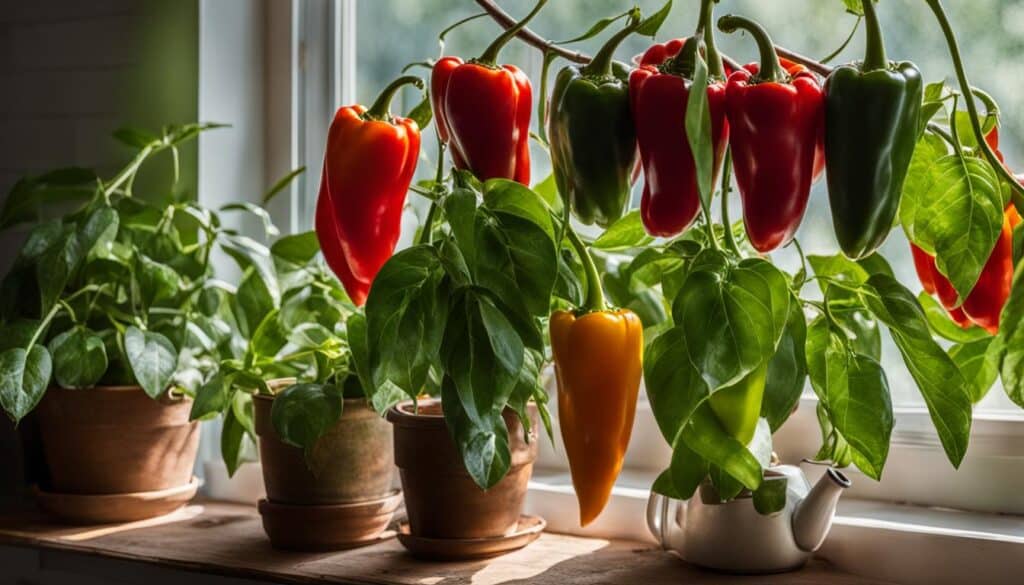
Benefits of Growing Peppers Indoors
- Year-round supply of fresh and flavorful peppers
- Control over growing conditions, ensuring optimal light and temperature
- Ability to grow a variety of pepper types, from sweet to spicy
- Opportunity to experiment with different pepper-based recipes
- Decorative addition to your indoor garden, with vibrant colors and lush foliage
“Growing my own peppers indoors has been a game-changer for my cooking. I love having fresh jalapenos and bell peppers on hand whenever I need them. Plus, it’s a great conversation starter when guests see the vibrant plants in my kitchen!” – Emily, Indoor Gardening Enthusiast
Spring Onions – Grow them from scraps
Spring onions are a versatile and flavorful addition to many dishes, and the best part is, you can easily grow them from kitchen scraps right in your own home! With just the ends of the bulbs and a jar filled with water, you can watch these humble onions come back to life and thrive.
To get started, simply cut off the green tops of your spring onions, leaving about an inch or two of the white bulb intact. Place the bulbs in a jar with the roots facing down and fill the jar with enough water to cover the roots. Change the water every few days to keep it fresh and prevent any bacterial growth.
Within a week or two, you’ll start to see new growth as the onions begin to regrow. Once the green tops have reached your desired length, you can trim them and use them in your recipes, allowing the onions to continue regrowing for a continuous supply of fresh greens.
Benefits of Growing Spring Onions Indoors
Growing spring onions indoors not only provides you with a sustainable and cost-effective way to have fresh onions, but it also allows you to enjoy the process of regrowth and witness the magic of nature in your own home. Additionally, indoor onion gardening allows you to have a constant supply of fresh greens throughout the year, regardless of the outdoor season or weather conditions.
Indoor Onion Gardening Tips
- Choose spring onions that are fresh and healthy, with no signs of rot or disease.
- Use a clean and transparent jar to easily monitor the growth of the onions.
- Place the jar in a location that receives bright, indirect sunlight for optimum growth.
- Change the water every few days to prevent bacterial growth and ensure the onions have access to fresh nutrients.
- Trim the green tops of the onions when they reach the desired length, allowing for continued regrowth.
Table: Comparison of Different Types of Onions
| Type of Onion | Flavor | Best Uses |
|---|---|---|
| Spring Onions | Mild, slightly pungent | Salads, stir-fries, garnishes |
| Scallions | Mild, slightly sweet | Soups, stews, salsas |
| Red Onions | Mild, sweet | Sandwiches, burgers, salads |
| Yellow Onions | Pungent, full-bodied | Stews, sauces, sautés |
Strawberries – Fresh fruits all year round
When it comes to indoor gardening, strawberries are a popular choice that can provide you with fresh fruits throughout the year. Whether you have a spacious indoor garden or just a small corner, you can successfully grow strawberries indoors. By following a few key tips and techniques, you can enjoy the delicious taste of homegrown strawberries right at your fingertips.
One important aspect of growing strawberries indoors is choosing the right containers. You can opt for traditional pots or hanging containers, which allow you to make the most of your vertical space. It’s important to ensure that the containers have proper drainage to prevent waterlogging, as strawberries prefer moist but well-drained soil. You can also consider using a hydroponic system for growing strawberries, which provides an efficient and controlled environment for their growth.
Another crucial factor in successfully growing strawberries indoors is providing adequate sunlight. Strawberries require at least 6-8 hours of direct sunlight each day. If you don’t have access to sufficient natural light, you can supplement it with artificial grow lights. LED grow lights are particularly effective for indoor strawberry cultivation, as they provide the right spectrum of light for optimal growth and fruiting.
Proper care and maintenance are essential for the successful growth of indoor strawberries. Regular watering is important to keep the soil moist but not overly saturated. You should also regularly check for any signs of pests or diseases and take appropriate measures to prevent or treat them. Proper fertilization is necessary to provide the strawberries with the necessary nutrients for healthy growth and abundant fruit production. With time and patience, you can enjoy a bountiful harvest of sweet and juicy strawberries from the comfort of your home.
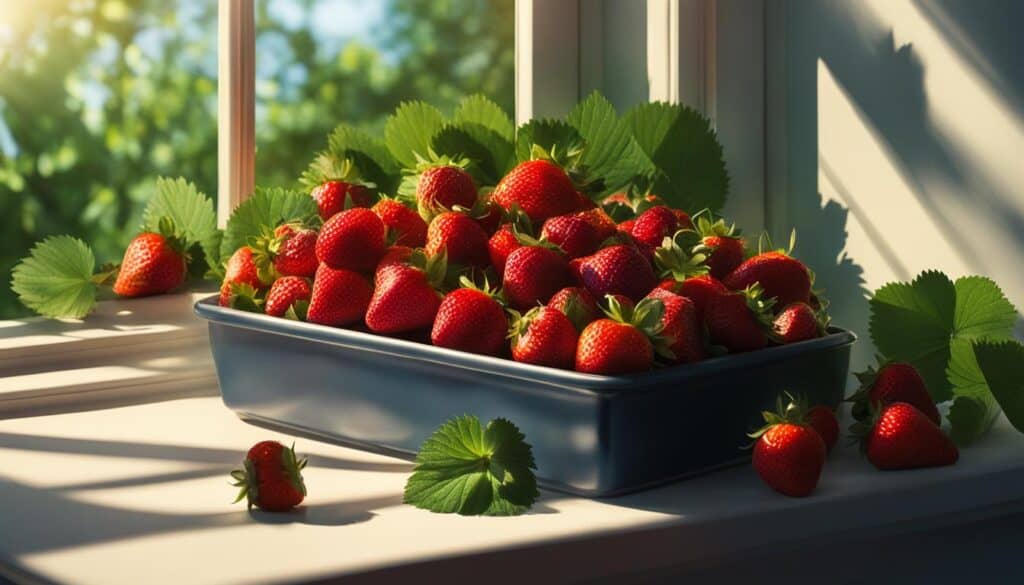
Tips for growing strawberries indoors:
- Choose the right containers with proper drainage for optimal growth.
- Provide at least 6-8 hours of direct sunlight each day or supplement with LED grow lights.
- Keep the soil moist but not overly saturated.
- Regularly check for pests and diseases and take appropriate measures to prevent or treat them.
- Fertilize the strawberries regularly to provide essential nutrients for healthy growth and fruit production.
Peas – A Versatile Addition to Your Indoor Veggie Harvest
Growing peas indoors can be a rewarding experience, providing you with a versatile addition to your indoor garden. Peas add a crisp texture and sweet flavor to a variety of dishes, making them a popular choice among home gardeners. Whether you’re a beginner or an experienced indoor gardener, here are some tips to help you successfully grow peas indoors.
Choosing the Right Pea Variety
When selecting pea varieties for indoor gardening, it’s important to choose compact or dwarf varieties that are well-suited for limited space. Snow peas and sugar snap peas are excellent choices as they are known for their bushy growth habits and can be easily trained on trellises or dowels. These varieties thrive in containers and require less vertical space, making them ideal for indoor cultivation.
To ensure a successful harvest, look for pea varieties that have a shorter maturity time. Some popular indoor pea varieties include ‘Little Marvel,’ ‘Tom Thumb,’ and ‘Dwarf Grey Sugar.’ These varieties typically reach maturity within 50-60 days and produce an abundant harvest of flavorful peas.
Providing Optimal Growing Conditions
Peas thrive in cool temperatures and require a minimum temperature of around 60°F (15°C) for optimal growth. Choose a location in your home that receives ample sunlight or use supplemental grow lights to provide the necessary light intensity. Aim for 12-16 hours of light per day to promote healthy growth and flowering.
When it comes to soil, peas prefer well-draining soil with a pH between 6.0 and 7.0. Use a high-quality potting mix or create a custom blend by combining equal parts of compost, perlite, and peat moss. Make sure to provide adequate water drainage by using containers with drainage holes or adding a layer of gravel at the bottom of the pot.
Caring for Your Pea Plants
Regular watering is essential for the healthy growth of pea plants. Keep the soil consistently moist but avoid overwatering, as this can lead to root rot and other fungal diseases. Feel the top inch of soil, and if it feels dry, it’s time to water. Be mindful of temperature fluctuations, as overly warm conditions can cause the plants to become stressed and negatively affect their productivity.
As your pea plants grow, provide support using dowels, trellises, or stakes. This helps the plants stay upright and prevents them from sprawling on the ground. Gently guide the vines up the support structure as they grow, taking care not to damage the delicate tendrils.
Regularly monitor your pea plants for pests such as aphids or powdery mildew. If you notice any signs of infestation, promptly treat the affected plants with organic pest control methods to prevent further damage.
| Indoor Pea Varieties | Sunlight Requirements | Maturity Time |
|---|---|---|
| ‘Little Marvel’ | Full sun | 50-60 days |
| ‘Tom Thumb’ | Partial shade | 55-65 days |
| ‘Dwarf Grey Sugar’ | Full sun to partial shade | 60-70 days |
With a little patience and care, you can enjoy a bountiful harvest of delicious peas right from the comfort of your home. Whether you use them in stir-fries, salads, or as a nutritious snack, freshly harvested peas from your indoor garden will add a burst of flavor and color to your culinary creations.
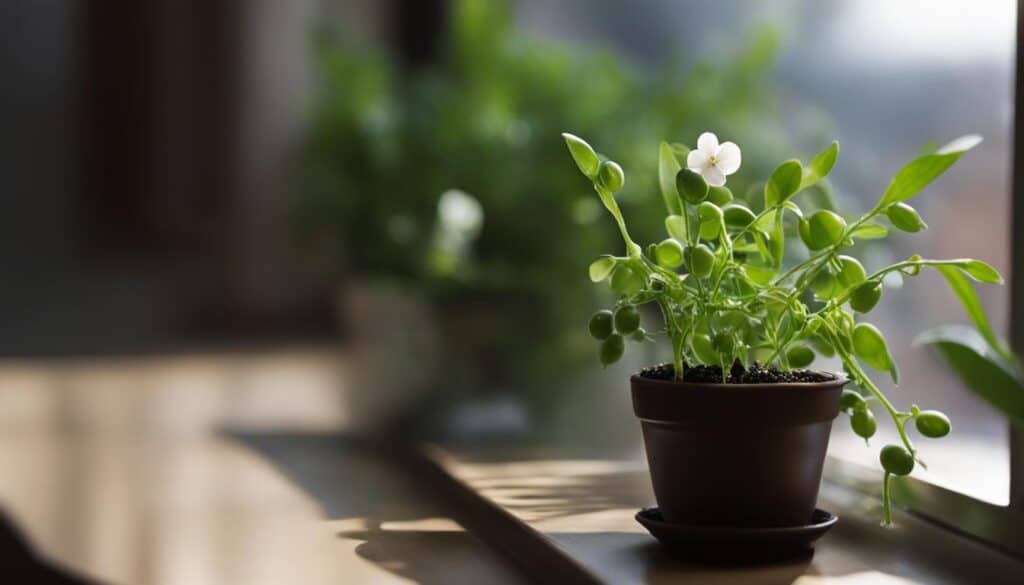
Squash – Adding lush greens to your indoor space
Growing squash indoors is a rewarding way to bring a touch of freshness and greenery to your indoor space. With a variety of squash plants to choose from, such as zucchini, patty pan, acorn, and butternut squash, you can enjoy the beauty and taste of homegrown vegetables all year round. Whether you germinate seeds from a squash you’ve eaten or purchase plants for convenience, growing squash indoors is a great option for those with limited outdoor space or colder climates.
When growing squash indoors, it’s important to provide your plants with adequate space to spread out. Squash plants have large leaves and vines that can quickly take over a small area. Choose a corner or side area where your plants can have enough room to grow without overcrowding other plants. Ensure sufficient sunlight or use grow lights to provide the necessary light for optimal growth.
Proper care and maintenance are essential for successful indoor squash growing. Regularly water your plants, ensuring the soil is moist but not waterlogged. Monitor the humidity levels in your indoor space and consider using a humidifier if necessary, as squash plants thrive in higher humidity environments. Additionally, be on the lookout for pests and diseases and take appropriate measures to protect your plants.
Indoor Gardening Tips for Squash:
- Choose a sunny spot or use grow lights to provide sufficient light for your squash plants.
- Ensure your plants have ample space to grow and spread out.
- Water your plants regularly, keeping the soil moist but not overly saturated.
- Monitor humidity levels and consider using a humidifier if needed.
- Keep an eye out for pests and diseases, taking preventive measures when necessary.
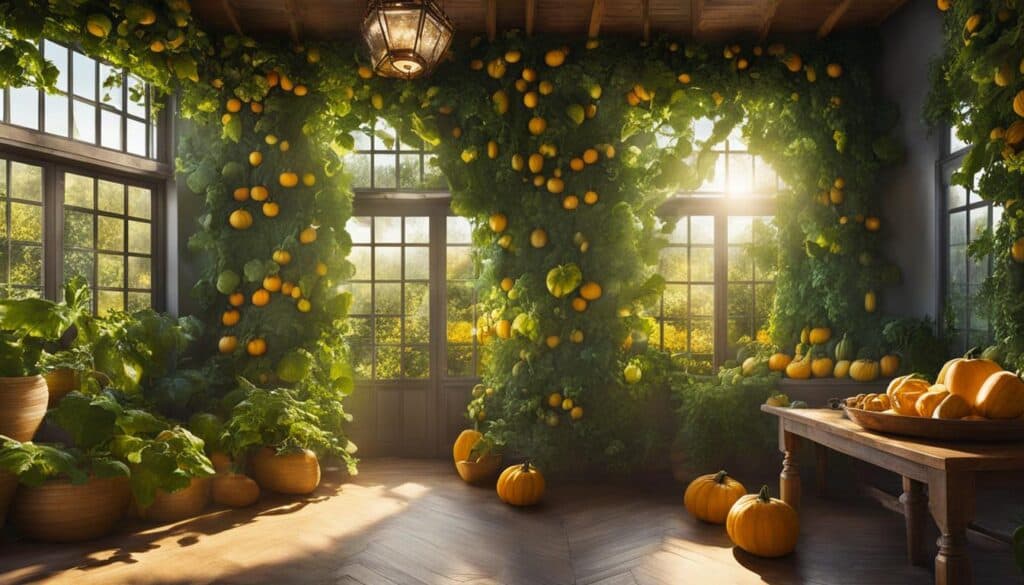
With a little patience and care, you can enjoy the lush greens and delicious harvest of homegrown squash right in your indoor space. Whether you use them in soups, stir-fries, or even stuffed with your favorite fillings, the versatility of squash adds a delightful touch to your culinary creations. So, why not give indoor squash growing a try and bring the beauty and taste of fresh vegetables into your home?
Conclusion
Growing fruit indoors offers a multitude of benefits, allowing you to enjoy year-round fresh produce regardless of your outdoor space limitations. Whether it’s crisp lettuce, flavorful microgreens, fragrant citrus trees, or sweet strawberries, indoor gardening provides a controlled environment that ensures optimal growing conditions for your plants.
The benefits of indoor gardening go beyond the convenience of having fresh fruits at your fingertips. By cultivating your own indoor fruit garden, you can have peace of mind knowing the source of your food and reduce the risk of contamination. Additionally, indoor gardening allows you to experiment with different varieties and flavors, adding a unique touch to your meals.
With techniques such as hydroponics, specialized containers, and proper care, you can create a thriving indoor fruit garden. Imagine the joy of plucking a ripe strawberry or harvesting vibrant lettuce leaves right from your own home. Embark on the journey of indoor fruit growing and savor the taste of homegrown, year-round fresh produce.
FAQ
What fruits can I grow indoors?
You can grow a variety of fruits indoors, including lettuce, microgreens, citrus trees, peppers, spring onions, strawberries, peas, squash, banana trees, and mushrooms.
How do I grow lettuce indoors?
Lettuce can be grown indoors in containers that are at least 6 inches deep. You can grow different types of lettuce, such as Bibb, leaf, and romaine, from seeds or pre-potted plants. Specialized devices like smart garden LED sets and hydroponic plant stands can help you grow lettuce indoors.
What are microgreens?
Microgreens are young, tender greens that are packed with flavor and nutrients. They can be grown indoors using just 2 inches of soil, making them perfect for small spaces.
How do I grow citrus trees indoors?
You can grow lemon, lime, orange, or grapefruit trees indoors by picking a sunny area and using a potted tree. It’s important to choose a self-pollinating variety or ensure there is a bee colony nearby for pollination.
How do I grow peppers indoors?
Small peppers like chilis are ideal for growing in sunny indoor spaces. Plant them in pots with good drainage and provide proper care to have a spicy addition to your indoor garden.
How can I grow spring onions indoors?
Spring onions can be easily regrown indoors using just the ends of the bulbs and a jar with water. Change the water every few days, and once they are ready to eat, trim them and continue regrowing for a continuous supply.
Can I grow strawberries indoors?
Yes, strawberries are a popular choice for indoor gardening. They can be grown in pots or hanging containers, allowing you to maximize your space.
Can I grow peas indoors?
Yes, peas are a great choice for indoor gardening. Snow peas and dwarf peas work well for year-round growing and require biweekly watering.
How can I grow squash indoors?
You can grow squash plants indoors, such as zucchini, patty pan, acorn, and butternut squash. Follow care guides and provide ample space for the plants to grow.
What are the benefits of growing fruit indoors?
Growing fruit indoors allows you to have fresh produce all year round, regardless of your outdoor space limitations. It provides a controlled environment, ensuring optimal growing conditions for your plants. It also allows you to enjoy the benefits of homegrown produce, such as knowing the source of your food and reducing the risk of contamination.

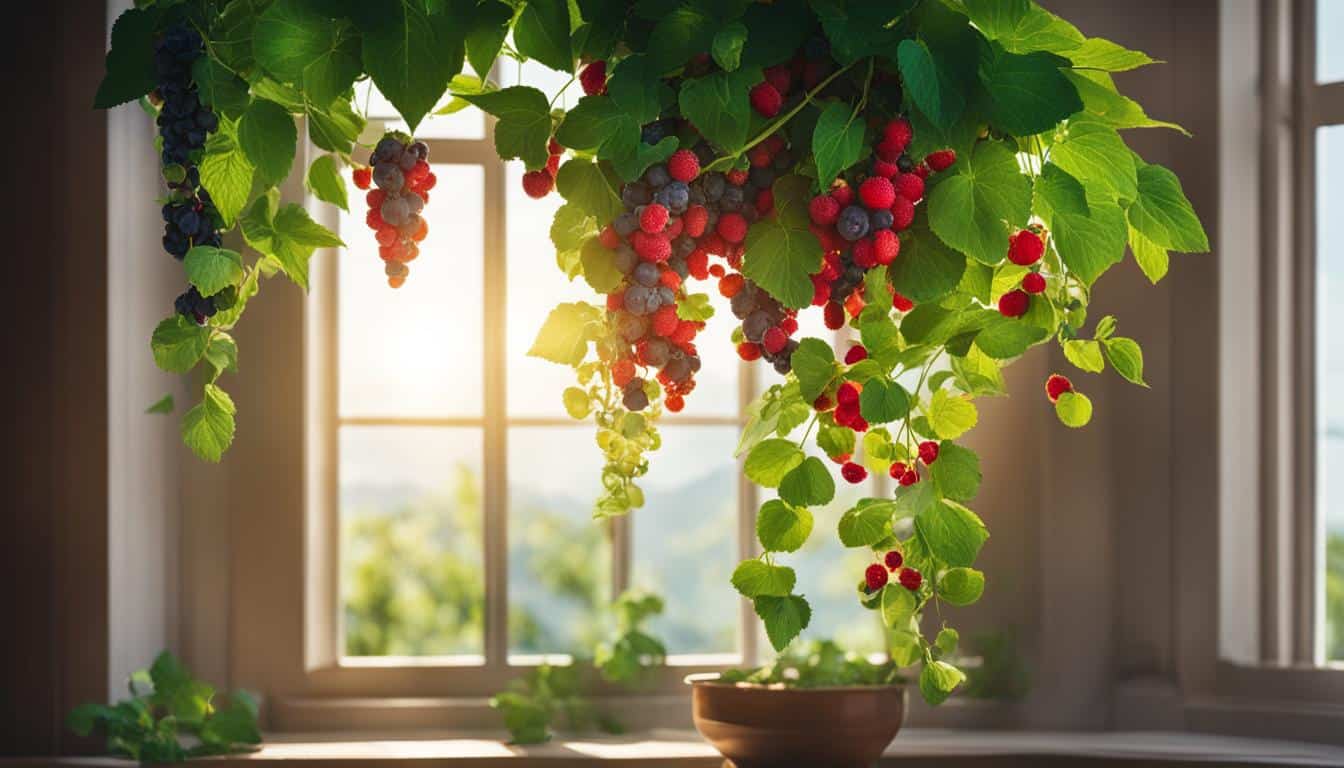



Leave a Reply